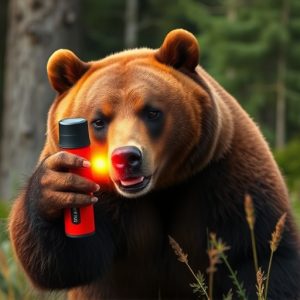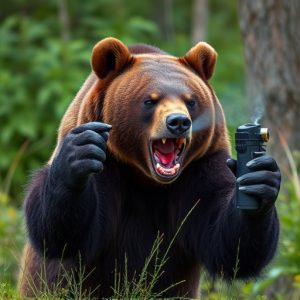Bear Spray Range & Legal Status: Understanding Effectiveness & Best Practices
Bear spray, a non-lethal repellent, is widely accessible and legal in regions with bears, offering h…….
Bear spray, a non-lethal repellent, is widely accessible and legal in regions with bears, offering hikers and campers self-defense against aggressive bears. It contains capsaicin and piperidine carboxylic acid, temporarily incapacitating or deterring bears within a 20-foot (6-meter) range. Despite its popularity, bear spray should complement noise-making and food storage practices for optimal protection. Legal status varies; understanding regional restrictions is crucial before use. Effective deployment requires calmness, appearing larger, and aiming for the face and eyes from 20-30 feet away. Responsible ownership and usage are essential in bear country.
“Discover the power of bear spray as a crucial non-lethal self-defense tool in encounters with aggressive bears. This comprehensive guide explores the science behind its effectiveness, ranging from 30 to 65 feet, making it a strategic choice for outdoor enthusiasts and professionals alike. Delve into legal considerations regarding bear spray as a restricted weapon, and learn factors influencing its range and performance. Additionally, gain insights on best practices for usage and storage.”
- Understanding Bear Spray: A Non-lethal Self-Defense Tool
- The Science Behind Bear Spray's Effectiveness
- Legal Considerations: Is Bear Spray a Restricted Weapon?
- Factors Influencing Bear Spray Range and Performance
- Best Practices for Using and Storing Bear Spray
Understanding Bear Spray: A Non-lethal Self-Defense Tool
Bear spray, also known as bear repellent, is a non-lethal self-defense tool designed to deter aggressive bears when faced with an encounter in their natural habitat. It’s not a weapon but rather a chemical agent that temporarily incapacitates or causes a bear to avoid an area. The active ingredients in bear spray typically include capsaicin, the same compound that makes chili peppers spicy, along with other chemicals like piperidine carboxylic acid. This combination creates a potent irritant that can cause bears to retreat quickly, providing time for individuals to escape or find safety.
Unlike firearms or other restricted weapons, bear spray is easily accessible and legal in many regions where bear encounters are common. It’s lightweight, easy to use, and requires no special training to operate effectively. However, it’s crucial to understand that bear spray is most effective when used properly and within its stated range. Always follow the instructions provided by the manufacturer for optimal performance, and remember that while bear spray can be a valuable tool in bear country, it should complement other safety measures like making noise to deter bears and knowing how to react during an encounter.
The Science Behind Bear Spray's Effectiveness
The science behind bear spray’s effectiveness lies in its ability to create a temporary yet powerful barrier between you and an aggressive bear. Bear spray is a specialized pepper spray designed with capsaicin, the active ingredient found in chili peppers. When sprayed, it irritates the bear’s eyes, nose, and respiratory system, causing them to recoil and retreat. Studies have shown that when used correctly, bear spray can be effective up to 20 feet (6 meters) away, making it a valuable tool for hikers, campers, and others encountering bears in their natural habitat.
While often considered an alternative to firearms, bear spray is not classified as a restricted weapon. This distinction allows for easier accessibility and portability, making it a convenient option for those seeking protection against bears without the need for more regulated armaments. However, it’s crucial to understand that bear spray is most effective when used in conjunction with other bear safety practices, such as making noise while hiking and storing food securely.
Legal Considerations: Is Bear Spray a Restricted Weapon?
The legal status of bear spray is an essential consideration for anyone planning to carry it while hiking or camping in areas known for bear activity. In many jurisdictions, bear spray is classified as a restricted weapon due to its potent pepper spray composition and potential for harm if misused. This classification often comes with strict regulations regarding who can purchase, possess, and use it.
The restrictions vary widely across different regions, with some places requiring permits or specialized training to legally carry bear spray. It’s crucial for users to understand their local laws and comply with any additional requirements to ensure they are not breaking any rules. Non-compliance can result in hefty fines or legal repercussions, adding an extra layer of complexity to outdoor adventures in bear country.
Factors Influencing Bear Spray Range and Performance
The effectiveness of bear spray as a deterrent depends on various factors, and understanding these can help users make informed decisions when venturing into potential bear country. One key aspect is the range at which the spray can be effectively deployed. Bear spray ranges typically vary from 2 to 30 feet (depending on the brand and nozzle type), but certain conditions can influence this distance. Wind direction and speed play a significant role; a strong headwind can reduce the reach of the spray, while a tailwind might extend it.
Another factor is the bear’s behavior. Black bears, for instance, tend to avoid confrontation unless they feel threatened or are protecting their cubs. Therefore, the likelihood of successful deterrence may vary based on the species and its natural disposition. Moreover, the distance at which a bear spray can be used effectively isn’t just about the physical range but also the visibility and clarity of the area. Obstructions like trees or rocks can obstruct the spray’s path, reducing its impact range. In light of these variables, it’s essential to recognize that bear spray serves as a tool for deterrence rather than a guaranteed weapon, especially when considering if bear spray is restricted as a weapon in certain regions.
Best Practices for Using and Storing Bear Spray
Using bear spray effectively requires adhering to best practices for optimal protection. When encountering a bear, remain calm and assess the situation. If the bear hasn’t noticed you, make yourself appear larger by raising arms or wearing a bright jacket. Speak firmly and slowly to convey that you’re not a prey item. If the bear continues to approach, activate the spray in a sweeping motion across the bear’s face and eyes, aiming for a distance of 20-30 feet (6-9 meters). The goal is to create a barrier between you and the bear, not necessarily to blind it.
Proper storage is equally important for maintaining the spray’s effectiveness. Bear spray should be kept in its original packaging, stored in a cool, dry place, and out of direct sunlight. Ensure it’s secured so it doesn’t fall or tip over, as this could compromise the canister and reduce its range. Check the expiration date regularly, as these products have a limited shelf life. Given that bear spray is not considered a restricted weapon, proper ownership and usage are crucial for safety in bear country.
Bear spray, while not universally classified as a restricted weapon, is an essential non-lethal self-defense tool for navigating wild environments. Understanding its science-backed effectiveness and legal considerations, along with optimal use and storage practices, can significantly enhance safety in bear country. By knowing the factors influencing its range and performance, individuals can make informed decisions to protect themselves and reduce conflict with these majestic yet potentially dangerous animals.


